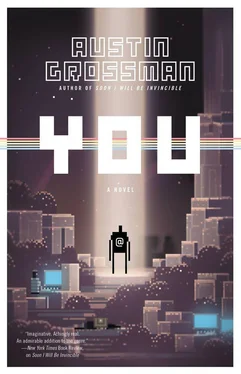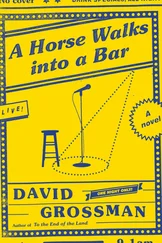After a while Matt noticed I was there and rescued me. He looked about fifteen, and must have been older than that but was still plausibly younger than the Realms of Gold franchise itself. On second viewing he was still disconcertingly large; his face seemed to widen from the top downward, like that of an Easter Island statue. He was an assistant producer, it turned out, a catchall workhorse position.
Black Arts was mostly the one big room, so we walked the perimeter, passing the wall of trophies and plaques: Game of the Year 1992, Game of the Year 1994. There was an early company photo, with Simon glowering at the extreme left, only three years from death. A poster showed the Milky Way galaxy with four enormous faces looking down on it, along with the words: Solar Empires III: Pan-Stellar Activation .
“Mostly people are on break from shipping Solar Empires, that’s why nobody’s here.” He stopped at a U-shaped formation of maybe a dozen desks. It was mostly empty. “This is the design pit, where you’ll be.”
The short guy from my job interview was at a desk, playing a version of Doom modified to have Flintstones characters instead of space marines. He was wearing a top hat.
“Hey,” he said without looking up. “I’m Jared.”
“We met,” I said.
“I guess Russell’s going to be working on the new thing,” Matt explained.
“Wait; what’s the new thing?” I asked.
“It’s still secret,” Matt said. “Darren will tell us when he’s ready.”
“It had better not be space. I’m so fucking sick of space.” The voice came from the other side of the divider, an older man, bald, who wore a leather vest over a dark blue button-down shirt, like a Radio Shack manager who moonlighted as a forest brigand. I’d noticed him as we passed because his monitor showed a 3-D image of a brick wall, and he’d been sitting there pushing the camera a quarter inch to the left, then a quarter inch to the right, over and over, watching for some infinitesimal change.
“The market wants sci-fi, Toby,” Jared said.
“I’m so fucking sick of drawing planets.” He slumped in his chair and went back to tapping the arrow keys.
“Here’s where you’ll be sitting,” Matt said. “We’ve got your work machine set up.”
I’d had only one computer since freshman year, a Compaq Presario with a 486 CPU and a thirteen-inch monitor that at the time had looked like the last computer that ever needed to be made. The off-white slab felt expensive and contemporary and powerful. But over the next four years the white casing acquired smudges and Rage Against the Machine stickers; it sagged and slowed under the load of next year’s word-processing software and the cumulative weight of cat hair clogging the cooling vents and being shoved under too many cheap desks in too many low-rent apartments, only to be yanked out three months later. I hated that machine.
Matt explained that the computer in front of me had a 200 MHz Pentium MMX processor, 32 MB of RAM, a 2 GB hard drive, a 12x CD-ROM drive, a fifteen-inch monitor, external speakers, and subwoofers. It was built for the overspecced world of 3-D gaming, and viewed all lesser tasks with an appropriate contempt.
Matt showed me a file called RoGVIed.exe, and suggested I “play around with it.” I shrugged and said, “Sure.” When he was gone, I clicked on it.
For a few seconds there was nothing, then a torrent of text scrolled by, too fast to follow. Then the screen blanked, then showed only the Black Arts logo for about a minute. Just when I thought the computer had frozen on me, the screen changed to a startlingly complex collection of buttons, widgets, icons, and maps. It was like a mad, complicated puzzle box, but I knew I’d found something—one of their treasures.
I was feeling a little terrified, but also thrilled—however tentatively, I’d pulled back the curtain on this dorky reality. I knew this must be the game editor, the designer’s basic tool, the thing that lets you do everything a designer does—build the geometry of the levels, place monsters and people and objects in it, put in any traps and surprises and, generally speaking, create a world in which you can menace and persecute anyone fool enough to enter. Here were the nuts and bolts of the world.
Only… I’d expected it to be a high-tech piece of wizardry—a 3-D display, rotating cubes and graphs and blue-green numbers. This—this thing looked like crap. No one had ever spent time making the editor pleasant to work with, and in fact its ergonomics were almost abusively wrong. The screen was divided into four quadrants, with no indication of where to begin or what they represented. Each had functions accessed through dozens of unreadably tiny icons, many of them virtually identical but for a pixel here and there, most of which had only the vaguest relationship to their functions. It must have been intuitively obvious to somebody, but I was lost. What was the question mark for, and why would I click on it? What was the snake for? The semicircle? The tiny automobile? And why didn’t anybody write any of this down?
No one was paying attention to me, and I slowly realized that this was their equivalent of job training—leaving me alone with a computer and a game editor just to see what I’d do. Like dropping a delicate tropical fish into a new aquarium—they’d come back in a few hours and I’d either be swimming around or floating at the top of the tank.
I poked at a few icons experimentally, but nothing seemed to happen. People were throwing me glances every once in a while; I saw Don peering out of his office at me. It came to me, gradually, that I was undergoing a test, a deliberate one. Not for technical literacy, because there was no way I could have learned this ahead of time. It wasn’t supposed to make sense. It was a test of character—could I sit with this patchy, buggy, undocumented piece of software and learn it by trial and error and not freak out, not be reduced to tears or incoherent rage? They wanted to know how much frustration I could stand.
The truth was, though, that for the first time in a very long time I was being given a test that made sense to me. I clicked, a section of map highlighted. I clicked somewhere else, I noted the result. I didn’t worry about making a mistake. The editor was designed with a perversity that shaded over into cruelty, but I sensed that once I learned its rules, I could live with it.
I learned by trial and error. I figured out how to raise and lower pieces of floor, to place blocks and monsters, how to apply colors to the terrain and objects. I learned that trying to save over a file with the same name crashed it to the DOS prompt.
The screen froze, and somebody walking past said, “Did you right-click in the 3-D window? You can’t do that.” I learned that clicking Save As while you had a piece of terrain selected meant you had to reboot. I learned that nobody ever clicked on the button labeled SMART MODE. Nobody knew what it did.
There was another test. At first I thought there was no manual whatsoever for how to use the editor, until I realized that the manual was the people in the room with me. You learned when it was okay to ask—you waited for a coder to launch a long compile or export, as signaled by a trip to the candy machine. You learned to distinguish the “I’m taking a break” stare (usually accompanied by a sigh or chair spin) from the “I’m thinking really hard” stare (straight ahead, or angled roughly fifteen degrees upward) and the “I’m really screwed up and angry” posture—elbows on desk, hands gripping head.
And you learned whom to ask. Todd was the nearest UI/tools guy but he was perennially cranky, so talk to Allison if she was around, or catch him when he’s just coming back from lunch, and always phrase the question so it sounds like you screwed up and are just looking to be rescued, not like there’s something actually wrong with the editor.
Читать дальше





![Ally Carter - [Gallagher Girls 01] I'd Tell You I Love You But Then I'd Have to Kill You](/books/262179/ally-carter-gallagher-girls-01-i-d-tell-you-i-lo-thumb.webp)






